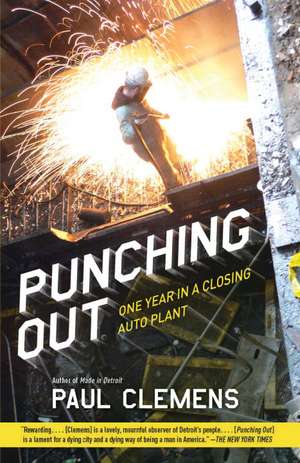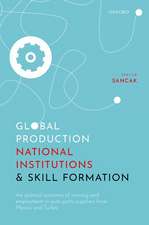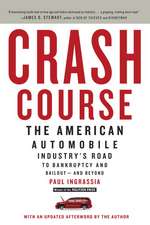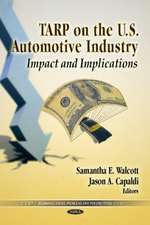Punching Out: One Year in a Closing Auto Plant
Autor Paul Clemensen Limba Engleză Paperback – 31 dec 2011
How does a country dismantle a century’s worth of its industrial heritage? To answer that question, Paul Clemens investigates the 2006 closing of one of America’s most potent symbols: a Detroit auto plant. Prior to its closing, the Budd Company stamping plant on Detroit’s East Side, built in 1919, was one of the oldest active auto plants in America’s foremost industrial city—one whose history includes the nation’s proudest moments and those of its working class. Its closing also reflects the character of the country in a new era—the sad, brutal process of picking it apart and sending it, piece by piece, to the countries that now have use for its machines.
Punching Out is an up-close report, at once tender and angry, from the meanest, sharpest edge of America’s deindustrialization, and a lament for a working-class culture that once defined a prosperous America—and that is now on the verge of economic extinction.
Preț: 99.94 lei
Nou
Puncte Express: 150
Preț estimativ în valută:
19.12€ • 20.02$ • 15.82£
19.12€ • 20.02$ • 15.82£
Carte disponibilă
Livrare economică 15-29 martie
Preluare comenzi: 021 569.72.76
Specificații
ISBN-13: 9780767926935
ISBN-10: 0767926935
Pagini: 271
Dimensiuni: 132 x 202 x 14 mm
Greutate: 0.2 kg
Editura: Anchor Books
ISBN-10: 0767926935
Pagini: 271
Dimensiuni: 132 x 202 x 14 mm
Greutate: 0.2 kg
Editura: Anchor Books
Notă biografică
PAUL CLEMENS was born in 1973 and raised on Detroit’s East Side. His work has appeared in the New York Times and the New York Times Magazine. His book Made in Detroit (Doubleday, 2005) was a 2005 New York Times Book Review Notable Book. He is the recipient of a Guggenheim Fellowship and a Whiting Writers' Award.
Extras
WHEN JON CLARK started his newsletter, Plant Closing News, in 2003, he promised subscribers that he’d report on the specifics of 25 plant closings a month—300 per year. In 2003, he reported on 983; the next year, 1,130; the next, 1,180. When I first talked to him, in October 2007, he’d reported who, what, when, where, and why on 980 plant closings in the calendar year—“that’s so far,” he stressed, “plus an additional 250 bankruptcies.”
The newsletter comes out biweekly and is “targeted to surplus industry service providers,” including “rebuilders, used equipment dealers, dismantlers, demolishers, remediation contractors, equipment riggers, craters, and equipment transport firms looking for current business opportunities, particularly those arising from the closing or relocating of North American industrial manufacturing plants.” Each issue begins by noting the number of closings in the United States and Canada included in the issue. For instance, the January 15, 2007, issue is headlined: “44 Companies Closing 48 Plants + 18 Bankruptcies.” These are then subdivided by industry— food processing, textile products, wood products, pulp, paper products, chemical products, rubber, plastics products, glass, cement products, metal products, electrical, electronics, other manufacturers—and again by state—“AL 2, FL 3, MI 6”— before the specifics of each closing are given. Clark recalled getting a phone call from a manager at a plant in Arkansas angry that his plant had appeared in the newsletter. Clark pointed out that the closing had already made the papers.
Clark has also written Plant Closing Checklist, which includes a couple hundred questions and comments covering areas pertinent to plant closure. “Know what one of the first things on the Plant Closing Checklist is?” Clark asked. “Tell your people what’s going on!” His memory for individual plant closings is unusually good. When we first spoke on the phone, I told him I was working on a book about the closing of the Budd Detroit Automotive Plant, Stamping and Frame Division. “That was a two- million-square- foot facility,” Clark said of the plant, whose closing had appeared in the July 15, 2006, issue of Plant Closing News. He has industrial facts and figures at his mental fingertips, and his knowledge of plant closings is sought after. The Democratic National Committee had contacted him in the buildup to the presidential election of 2004 in an attempt to determine “how many jobs had been exported under Mr. Bush.” It was a question impossible to answer exactly but one that led Clark to a larger point. “I tell you what,” he said he told the Democrats. “If you can get everybody to vote for you that’s lost their job in this country, you can easily be elected.” He added, “And that was four years ago. And that’s five thousand plant closures ago. And I think that had a big impact on Obama being elected.”
We met over breakfast in the Houston airport a week after the 2008 presidential election, when the depth of the country’s financial crisis was becoming clear. The Great Recession had officially begun eleven months before, and later that month the leaders of Detroit’s Big Three would arrive in Washington for a public flogging—a prelude, for General Motors and Chrysler, to the bankruptcies to come. Auto suppliers—Delphi, Lear, Tower Automotive, Dana, Dura—were ahead of the downward curve, beating GM and Chrysler into bankruptcy by years. Budd, a major Tier 1 supplier, avoided the possibility of a similar fate by simply closing.
I had flown from Detroit to Houston to talk to Clark while en route to central Mexico to see a press line. Once the largest press line in the Budd Detroit plant, stamping body sides for the Ford Explorer and Ford Expedition, it had been sold after the Budd plant’s closure to Gestamp, a Spanish auto supplier. Gestamp had the disassembled presses moved, piece by piece, a couple of thousand miles to its newly expanded plant in Aguascalientes, Mexico, where it was now stamping body sides for the Dodge Journey, the Chrysler crossover assembled in Toluca, Mexico.
I’d observed the disassembly of that press line, along with much of the rest of the Budd Detroit plant’s equipment, for the better part of a year. The trip to Mexico would cap a pro cess that had begun two and a half years before, on May 15, 2006, when ThyssenKrupp Budd, citing the declining sales of the Ford SUVs for which it supplied components, announced that it would close its Detroit plant by year’s end. The Budd plant had been built in 1919 by Liberty Motor—which, like most motor companies in Detroit’s early days, would soon go bust—and bought by the Budd Company in 1925. The German steel giant Thyssen bought Budd in the late 1970s and merged with the German steel giant Krupp in the late 1990s. The Budd Company became the ThyssenKrupp Budd Company in 2002, though no one called it that. “Budd,” “Budd’s,” and “Budd Wheel”— so- called after its former Wheel and Brake Division—were the plant’s names around town. The new name with the German prefix lasted just four years anyway: the Detroit plant closed, officially, on December 4, 2006. A sign saying “ThyssenKrupp Budd Detroit Plant” still hangs on the exterior of the empty plant—a misleading headstone on an exhumed industrial grave. At its peak, plant employment approached ten thousand.
The papers took note of its announced closing. The headline in the New York Times, via Bloomberg, got what and where (“Detroit Parts Plant Closing”), the headline in the Detroit News got why (“Landmark Plant Shuts as Sales of SUVs Fall”), and the headline in the Detroit Free Press got who (“ThyssenKrupp to Shut Down Detroit Plant”). The story was small and faded fast. The next day brought bigger news, when the FBI began to dig, at a horse farm in suburban Detroit, for the remains of Jimmy Hoffa.
I read the articles, read the company press release, and then called the vice president for public affairs at Thyssen -Krupp Budd who’d penned the release. I explained over lunch weeks later that I wanted to observe, up close, the plant- closing process. The public affairs VP, a pleasant man, said he’d support the project. Some time after, his decision was reversed. Someone above him had said no, or nein, and so I looked for other avenues into the plant. In Detroit, as in any big city, there are always several ways to get somewhere.
The headline appears daily in some American city: “Plant to Close.” I wondered—what then? I was born and raised in Detroit, world capital of closed auto plants, and I hadn’t a clue. I knew what such plant closings meant—more lost jobs, another abandoned building—but no clear sense of what they actually entailed.
The locations of auto plants and car shops were the latitude and longitude lines that oriented my upbringing. My father worked in shops all over town. I’d worked a couple summers for a small Detroit camshaft shop—now closed—in which my father had worked when I was a small boy. I’d begun life, according to Catholic belief, in a Detroit plant now so thoroughly closed it’s nonexistent. The Uniroyal Tire plant, formerly the U.S. Rubber Company plant, where my mother worked as a secretary while pregnant with me, was on Jefferson Avenue, a couple miles south and west of the Budd plant. At the time, it employed five thousand. “There’s Uniroyal,” my mom would say, years later, as we drove down Jefferson, motioning to an empty parcel of land. The British writer Geoff Dyer, visiting the city early this century, noted that “in Detroit...everything is where something used to be.” This is true, though Dyer shows himself an outsider by saying so. The “where something used to be” clause is, to Detroiters, a bit of implied conversation, like the “good” that country folk habitually omit from their “Mornin’!”
As a plant on the city’s East Side, Budd was in my industrial backyard. An uncle of mine had grown up on Anderdon, a block east of the Budd plant. My grandmother had gone to Southeastern High School, a couple blocks west of the plant. My grandfather had lived on Springle, three blocks east of the plant. I had long harbored vague plans for a book on the decline of the American working class, and when I scanned the papers on the morning of May 16, 2006, I was looking, in the unseemly way of writers, for a symbol of that decline. That the Budd plant was within Detroit’s city limits, as old as the hills, and four miles from my front door made me feel light- headed with dumb luck.
The American working class has not only declined; it has transformed. During the last presidential campaign, the New York Times Magazine noted that though factory workers may still represent the working class for purposes of political theater, the United States now has more choreographers than metal casters, more people dealing cards in casinos than running lathes, and almost three times as many security guards as machinists— a massive shift away from industrial work among the working class. Productivity increases had greatly reduced the need for industrial workers, and such workers as were needed were easily and cheaply found outside the United States. On the day of the Michigan presidential primaries, National Public Radio reported that the state had lost 200,000 manufacturing jobs since 2000. The country as a whole had lost 4 million since 1999. One stumbled across such statistics at every turn. Figures differed, depending on source and date, but went in one direction, demanding additional commas and zeros. Industrial work, for working- class folk, was hard to come by.
The working class is to Detroit what immigrants are to New York, prospectors to California, prisoners to Australia: the people who put the place on the map, and who continue to populate its psychic space. There are few in Detroit who would describe themselves as anything but. If someone has done particularly well, he’ll cite, proudly, the working- class stock from which he springs. Typically, though, the poor round up, the middle classes round down, and everyone, in the American spirit of self- selection, meets in that broad stratum of society that, by the sweat of its brow, scrapes by. What I thought I had seen inside the closed Budd Detroit plant through a particularly bad summer, fall, winter, and spring was the American working class, mopping up after itself.
The newsletter comes out biweekly and is “targeted to surplus industry service providers,” including “rebuilders, used equipment dealers, dismantlers, demolishers, remediation contractors, equipment riggers, craters, and equipment transport firms looking for current business opportunities, particularly those arising from the closing or relocating of North American industrial manufacturing plants.” Each issue begins by noting the number of closings in the United States and Canada included in the issue. For instance, the January 15, 2007, issue is headlined: “44 Companies Closing 48 Plants + 18 Bankruptcies.” These are then subdivided by industry— food processing, textile products, wood products, pulp, paper products, chemical products, rubber, plastics products, glass, cement products, metal products, electrical, electronics, other manufacturers—and again by state—“AL 2, FL 3, MI 6”— before the specifics of each closing are given. Clark recalled getting a phone call from a manager at a plant in Arkansas angry that his plant had appeared in the newsletter. Clark pointed out that the closing had already made the papers.
Clark has also written Plant Closing Checklist, which includes a couple hundred questions and comments covering areas pertinent to plant closure. “Know what one of the first things on the Plant Closing Checklist is?” Clark asked. “Tell your people what’s going on!” His memory for individual plant closings is unusually good. When we first spoke on the phone, I told him I was working on a book about the closing of the Budd Detroit Automotive Plant, Stamping and Frame Division. “That was a two- million-square- foot facility,” Clark said of the plant, whose closing had appeared in the July 15, 2006, issue of Plant Closing News. He has industrial facts and figures at his mental fingertips, and his knowledge of plant closings is sought after. The Democratic National Committee had contacted him in the buildup to the presidential election of 2004 in an attempt to determine “how many jobs had been exported under Mr. Bush.” It was a question impossible to answer exactly but one that led Clark to a larger point. “I tell you what,” he said he told the Democrats. “If you can get everybody to vote for you that’s lost their job in this country, you can easily be elected.” He added, “And that was four years ago. And that’s five thousand plant closures ago. And I think that had a big impact on Obama being elected.”
We met over breakfast in the Houston airport a week after the 2008 presidential election, when the depth of the country’s financial crisis was becoming clear. The Great Recession had officially begun eleven months before, and later that month the leaders of Detroit’s Big Three would arrive in Washington for a public flogging—a prelude, for General Motors and Chrysler, to the bankruptcies to come. Auto suppliers—Delphi, Lear, Tower Automotive, Dana, Dura—were ahead of the downward curve, beating GM and Chrysler into bankruptcy by years. Budd, a major Tier 1 supplier, avoided the possibility of a similar fate by simply closing.
I had flown from Detroit to Houston to talk to Clark while en route to central Mexico to see a press line. Once the largest press line in the Budd Detroit plant, stamping body sides for the Ford Explorer and Ford Expedition, it had been sold after the Budd plant’s closure to Gestamp, a Spanish auto supplier. Gestamp had the disassembled presses moved, piece by piece, a couple of thousand miles to its newly expanded plant in Aguascalientes, Mexico, where it was now stamping body sides for the Dodge Journey, the Chrysler crossover assembled in Toluca, Mexico.
I’d observed the disassembly of that press line, along with much of the rest of the Budd Detroit plant’s equipment, for the better part of a year. The trip to Mexico would cap a pro cess that had begun two and a half years before, on May 15, 2006, when ThyssenKrupp Budd, citing the declining sales of the Ford SUVs for which it supplied components, announced that it would close its Detroit plant by year’s end. The Budd plant had been built in 1919 by Liberty Motor—which, like most motor companies in Detroit’s early days, would soon go bust—and bought by the Budd Company in 1925. The German steel giant Thyssen bought Budd in the late 1970s and merged with the German steel giant Krupp in the late 1990s. The Budd Company became the ThyssenKrupp Budd Company in 2002, though no one called it that. “Budd,” “Budd’s,” and “Budd Wheel”— so- called after its former Wheel and Brake Division—were the plant’s names around town. The new name with the German prefix lasted just four years anyway: the Detroit plant closed, officially, on December 4, 2006. A sign saying “ThyssenKrupp Budd Detroit Plant” still hangs on the exterior of the empty plant—a misleading headstone on an exhumed industrial grave. At its peak, plant employment approached ten thousand.
The papers took note of its announced closing. The headline in the New York Times, via Bloomberg, got what and where (“Detroit Parts Plant Closing”), the headline in the Detroit News got why (“Landmark Plant Shuts as Sales of SUVs Fall”), and the headline in the Detroit Free Press got who (“ThyssenKrupp to Shut Down Detroit Plant”). The story was small and faded fast. The next day brought bigger news, when the FBI began to dig, at a horse farm in suburban Detroit, for the remains of Jimmy Hoffa.
I read the articles, read the company press release, and then called the vice president for public affairs at Thyssen -Krupp Budd who’d penned the release. I explained over lunch weeks later that I wanted to observe, up close, the plant- closing process. The public affairs VP, a pleasant man, said he’d support the project. Some time after, his decision was reversed. Someone above him had said no, or nein, and so I looked for other avenues into the plant. In Detroit, as in any big city, there are always several ways to get somewhere.
The headline appears daily in some American city: “Plant to Close.” I wondered—what then? I was born and raised in Detroit, world capital of closed auto plants, and I hadn’t a clue. I knew what such plant closings meant—more lost jobs, another abandoned building—but no clear sense of what they actually entailed.
The locations of auto plants and car shops were the latitude and longitude lines that oriented my upbringing. My father worked in shops all over town. I’d worked a couple summers for a small Detroit camshaft shop—now closed—in which my father had worked when I was a small boy. I’d begun life, according to Catholic belief, in a Detroit plant now so thoroughly closed it’s nonexistent. The Uniroyal Tire plant, formerly the U.S. Rubber Company plant, where my mother worked as a secretary while pregnant with me, was on Jefferson Avenue, a couple miles south and west of the Budd plant. At the time, it employed five thousand. “There’s Uniroyal,” my mom would say, years later, as we drove down Jefferson, motioning to an empty parcel of land. The British writer Geoff Dyer, visiting the city early this century, noted that “in Detroit...everything is where something used to be.” This is true, though Dyer shows himself an outsider by saying so. The “where something used to be” clause is, to Detroiters, a bit of implied conversation, like the “good” that country folk habitually omit from their “Mornin’!”
As a plant on the city’s East Side, Budd was in my industrial backyard. An uncle of mine had grown up on Anderdon, a block east of the Budd plant. My grandmother had gone to Southeastern High School, a couple blocks west of the plant. My grandfather had lived on Springle, three blocks east of the plant. I had long harbored vague plans for a book on the decline of the American working class, and when I scanned the papers on the morning of May 16, 2006, I was looking, in the unseemly way of writers, for a symbol of that decline. That the Budd plant was within Detroit’s city limits, as old as the hills, and four miles from my front door made me feel light- headed with dumb luck.
The American working class has not only declined; it has transformed. During the last presidential campaign, the New York Times Magazine noted that though factory workers may still represent the working class for purposes of political theater, the United States now has more choreographers than metal casters, more people dealing cards in casinos than running lathes, and almost three times as many security guards as machinists— a massive shift away from industrial work among the working class. Productivity increases had greatly reduced the need for industrial workers, and such workers as were needed were easily and cheaply found outside the United States. On the day of the Michigan presidential primaries, National Public Radio reported that the state had lost 200,000 manufacturing jobs since 2000. The country as a whole had lost 4 million since 1999. One stumbled across such statistics at every turn. Figures differed, depending on source and date, but went in one direction, demanding additional commas and zeros. Industrial work, for working- class folk, was hard to come by.
The working class is to Detroit what immigrants are to New York, prospectors to California, prisoners to Australia: the people who put the place on the map, and who continue to populate its psychic space. There are few in Detroit who would describe themselves as anything but. If someone has done particularly well, he’ll cite, proudly, the working- class stock from which he springs. Typically, though, the poor round up, the middle classes round down, and everyone, in the American spirit of self- selection, meets in that broad stratum of society that, by the sweat of its brow, scrapes by. What I thought I had seen inside the closed Budd Detroit plant through a particularly bad summer, fall, winter, and spring was the American working class, mopping up after itself.
Recenzii
“Rewarding. . . . [Clemens] is a lovely, mournful observer of Detroit’s people. . . . [Punching Out] is a lament for a dying city and a dying way of being a man in America.” —Dwight Garner, The New York Times
“Clemens . . . paints the definitive portrait of a strange, resonant feature of the contemporary American landscape: the defunct factory . . . [this book] is an elegiac reminder of a scary truth lurking behind those abstract-sounding business headlines.” —Carlo Rotella, The Boston Globe
“Out of the painstaking job of dismantling industrial America, a story emerges. Clemens closes the book on one venerable factory, but leaves us wondering about the future of American work.” —San Francisco Chronicle
“Clemens has the street cred and old-school journalism chops to deliver a first-rate piece of deep reportage.” —Minneapolis Star Tribune
“Superb practitioners of immersion journalism older than Clemens include John McPhee, Gay Talese, Madeleine Blais, Susan Orlean, Walt Harrington, Mike Sager, Adrian Nicole LeBlanc and Tracy Kidder. Based on Punching Out, Clemens is a worthy addition to the list and an example for journalists not just in the United States, but around the globe. His story of another closed auto factory is sadly familiar. But it has never been told this well.” —Steve Weinberg, author of Taking on The Trust
“Clemens . . . paints the definitive portrait of a strange, resonant feature of the contemporary American landscape: the defunct factory . . . [this book] is an elegiac reminder of a scary truth lurking behind those abstract-sounding business headlines.” —Carlo Rotella, The Boston Globe
“Out of the painstaking job of dismantling industrial America, a story emerges. Clemens closes the book on one venerable factory, but leaves us wondering about the future of American work.” —San Francisco Chronicle
“Clemens has the street cred and old-school journalism chops to deliver a first-rate piece of deep reportage.” —Minneapolis Star Tribune
“Superb practitioners of immersion journalism older than Clemens include John McPhee, Gay Talese, Madeleine Blais, Susan Orlean, Walt Harrington, Mike Sager, Adrian Nicole LeBlanc and Tracy Kidder. Based on Punching Out, Clemens is a worthy addition to the list and an example for journalists not just in the United States, but around the globe. His story of another closed auto factory is sadly familiar. But it has never been told this well.” —Steve Weinberg, author of Taking on The Trust
Descriere
Clemens investigates the 2006 closing of one of America's most potent symbols: a Detroit auto plant. "Punching Out" is an up-close report from the meanest, sharpest edge of America's deindustrialization, and a lament for a working-class culture that once defined a prosperous America.






















